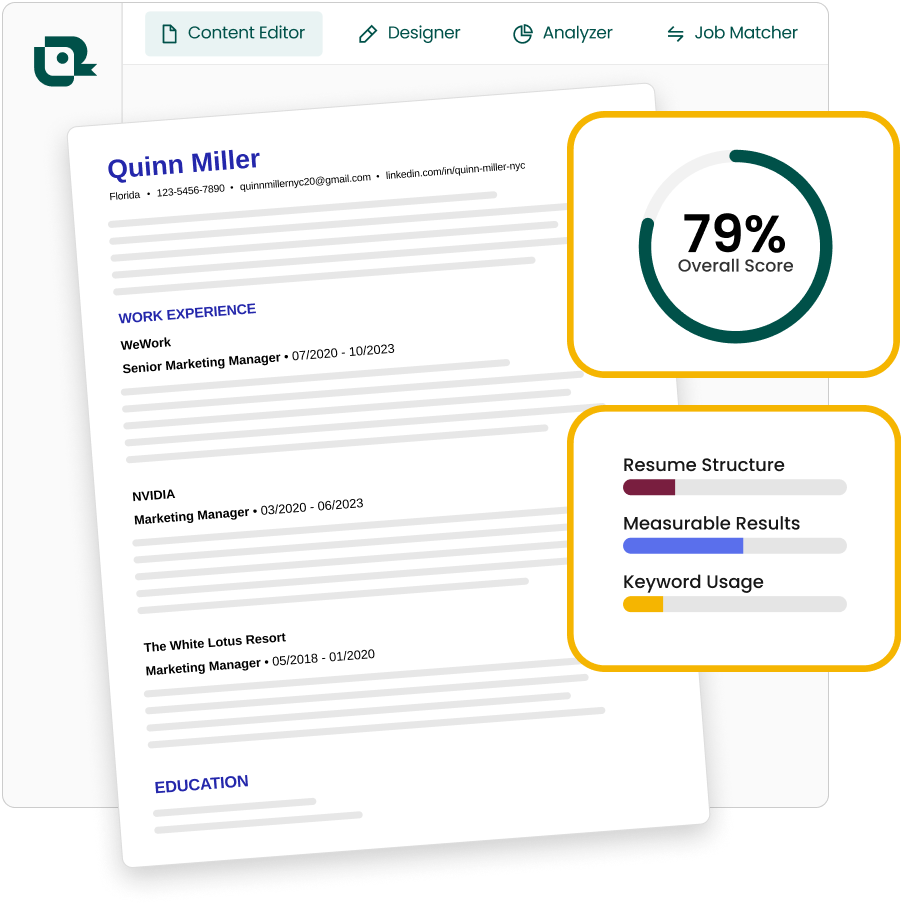3 Key Takeaways
- Showcasing promotions on your resume highlights your career growth and ambition, making you stand out to hiring managers.
- Use stacked entries to clearly display multiple roles within the same company, ensuring your progression is easy to follow.
- Build a tailored resume that effectively showcases your career growth using our AI Resume Builder, designed to optimize for ATS and hiring manager review.
Recruiters and hiring managers notice promotions when shuffling through candidate resumes, as they are a good indicator of a candidate’s potential performance. Have you had multiple promotions throughout your career? That progressions tells company leaders that you are ambitious, self directed and deliver results — qualities hiring managers love in candidates.
The challenge many candidates run into, however, is how to showcase promotions in a way that gets noticed but doesn’t look out of place from their other resume work experience. In this article, we share the best way to show promotions on your resume.
How To Show a Promotion Within a Company on Your Resume
The easiest way to show multiple promotions within a company on your resume is to create stacked entries. A stacked entry is when you’ve had multiple roles within one company, and is effective if you’ve been at the same company for many years.
Stacked entries are beneficial because they help organize your resume and communicate your career trajectory clearly to hiring managers.
Here are the steps for creating a stacked resume entry:
Step 1: List the company as a header
If you’ve received multiple promotions at one company, the best way to show a promotion on your resume is to list the company as a heading. From there, your job titles and responsibilities go in reverse chronological order. Using a header for each company is a simple way to separate multiple companies and the responsibilities held at each one.
Step 2: Add your most recent job role
Create a section under the company header that is specifically for your latest job role. Do not combine job titles in the same listing, as your promotions will not come across clearly to hiring managers.
Step 3: List 3-5 bullet points
Under each job title, include three-to-five bullet points that best describe your skills, experience and accomplishments within that title. Choose your bullet points based on the experience that is most relevant to the job you are pursuing. Remember to keep this part concise, as hiring managers sift through hundreds of resumes and prefer information that is communicated quickly and clearly.
Step 4: Repeat
If you have multiple job roles within one company or promotions throughout multiple companies, repeat the above steps. Remember to give each promotion its own opportunity to shine and only include your most relevant work experience.
Want to see what this looks like in its final form? Head over to our latest resume examples section and find a specific job title you want to see.
Promotion on Resume Examples
Everyone’s career experience is different, so showing a promotion on your resume may vary from person to person. Some people seek out promotions throughout various companies, while others are promoted internally. In these situations, what you’re capable of as an employee outweighs which companies you’ve worked for over time.
Below, we’ve outlined how to showcase promotions for both situations.
Showing multiple promotions within one company
There are many workers, though, who have received multiple promotions under one company. If this is your experience, list each job title as a separate entry under the company header and keep them in reverse chronological order, with the most recent position listed first.
Company name
Most recent job title, dates showing time spent in the role
- Explain your promotion
- Share your experience
- Share your responsibilities
- Share a measurable accomplishment
Company name
Second most recent job title, Dates showing time spent in the role
- Explain your promotion
- Share your experience
- Share your responsibilities
- Share a measurable accomplishment
Company name
Third most recent job title, Dates showing time spent in the role
- Share your experience
- Share your responsibilities
- Share a measurable accomplishment
The company name stays the same, but the job title, length of time, responsibilities and accomplishments are different.
Showing promotions across companies
If you have promotions across multiple companies, keep each company separate with its own header. Doing so will make your career growth more clear to recruiters and hiring managers. This format also works if you have only had one job title at your company prior to getting a promotion.
If you fall into this category, here is how you should structure your promotion:
Company name
Your job title, Dates showing length of time at the job
- Explain your promotion
- Share your experience
- Share your responsibilities
- Share a measurable accomplishment
In this format, the promotion is contained to one job listing.
You can apply these two options when showing a promotion on your LinkedIn profile as well.
Dos and Don’ts of Adding a Promotion Onto Your Resume
Resume writing has its own set of do's and don'ts; and there are ways to show a promotion on your resume that grab someone’s attention.
Below are a few simple dos and don’ts to follow when deciding which promotion to show and how to properly highlight it.
Do: Highlight your most relevant experience
If you have experience across diverse industries or are looking for a career change, only include your skills and experience that best coincides with the opportunity you are pursuing. Using this strategy is helpful if you have diverse job experiences or a lot of experience to pull from. As an example, take a look at what a highly relevant work experience looks like a for a marketing manager resume.
Don’t: Use cliches
“Hard worker,” “detail oriented,” “good communicator” and other resume cliches are empty ways to communicate your work experience. They also don’t tell hiring managers who you are, as you can pluck one of these cliches from your resume, pop it into someone else’s resume without knowing the difference. Action words that show what you’ve done or what you know will always outweigh cliches, so structure your resume to focus on why you were the best person for the promotion.
Do: Be specific
Like cliches, generic work experience won’t get a hiring manager’s attention. Numbers, stories and real-life examples do. Think about how to quantify your career. How many people do you work with? Have the number of subordinates increased since you were promoted? Are you responsible for increased sales? Adding specific numbers onto your resume not only shows what you’ve done but also the impact of your work.
Don’t: Save your promotion for the last bullet point
Highlighting a promotion as the first bullet point helps set you apart as a candidate. Promotions show you are self directed and a high achiever, which are two highly sought after qualities for recruiters and hiring managers.
A Free Way To Strengthen Your Resume
Resumes are a career investment; and a strong resume could determine whether you land an interview or not. Resumes are also exhausting and tedious to create, especially if you are unaware of the tips and tools available.
Teal is working to make the application process easier for career growers through free tools and content. Teal's AI Resume Builder, for example, cuts down the time it takes to create multiple resumes. It makes it easy to mix and match your experience to the job you are applying to.
Resume building often benefits from outside assistance, and Teal’s features can guide you toward a resume that will put you on a job shortlist.









